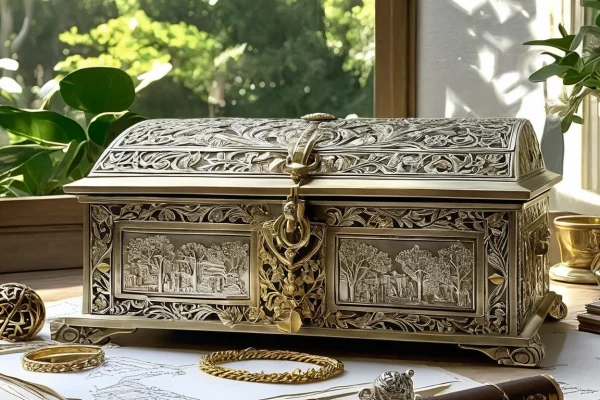Who Inspired the Growth of Tiffany & Co.?

The journey of Tiffany & Co. is nothing short of fascinating, marked by innovation, artistry, and a relentless pursuit of excellence. Founded in 1837, this iconic luxury jewelry brand has not only adorned countless individuals but has also carved a niche in the world of fashion and culture. But who were the key figures that fueled this remarkable growth? Let’s dive into the vibrant tapestry of influences that shaped Tiffany & Co. into the powerhouse it is today.
At the heart of Tiffany’s story is Charles Lewis Tiffany, the visionary founder whose commitment to quality and design set the standard for luxury jewelry. His pioneering spirit and dedication to craftsmanship laid the foundation for what would become a globally recognized brand. Under his leadership, Tiffany & Co. became synonymous with elegance and sophistication, attracting a clientele that included royalty and celebrities alike.
Following in his father’s footsteps, Louis Comfort Tiffany brought a fresh perspective to the brand. His artistic flair and expertise in stained glass and decorative arts expanded Tiffany’s creative horizons, elevating the company’s prestige. Louis’s contributions weren’t just about jewelry; they were about creating an experience that resonated with the artistic sensibilities of his time.
One cannot discuss Tiffany & Co. without mentioning the Tiffany Blue Box. This iconic packaging has become a symbol of luxury and elegance, representing the brand’s commitment to quality and exceptional customer service. It’s more than just a box; it’s a promise of the exquisite treasures inside, and it has significantly contributed to Tiffany’s global recognition.
| Influential Figures | Contributions |
|---|---|
| Charles Lewis Tiffany | Established the brand’s reputation for quality |
| Louis Comfort Tiffany | Expanded artistic vision and prestige |
Tiffany & Co. also revolutionized the marketing landscape within the jewelry industry. By embracing creative advertising strategies and celebrity endorsements, the brand enhanced its image and attracted a diverse clientele. The blend of tradition and modernity is evident in their collaborations with renowned artists and designers, which have enriched their product offerings and appealed to contemporary consumers.
As Tiffany & Co. continues to grow, its strategic global expansion reflects a keen understanding of international markets, allowing it to establish a presence in luxury shopping destinations worldwide. The cultural impact of Tiffany extends beyond jewelry, influencing fashion, art, and popular culture, solidifying its status as a timeless symbol of love and celebration.
In conclusion, the legacy of Tiffany & Co. is built on innovation, quality, and heritage, shaping the future of luxury jewelry retail. Each figure and strategy has played a crucial role in this journey, making Tiffany & Co. not just a brand, but a cultural icon.
Charles Lewis Tiffany
, the visionary founder of Tiffany & Co., was a force to be reckoned with in the world of luxury jewelry during the 19th century. His passion for quality and innovation laid the groundwork for what would become one of the most recognized brands globally. Imagine a time when jewelry was often considered mere trinkets; Charles changed that perception by establishing a new standard of excellence. He believed that jewelry should not only be beautiful but also an embodiment of craftsmanship and artistry.
Under his leadership, Tiffany & Co. introduced several revolutionary concepts that transformed the jewelry industry. Some notable contributions include:
- Quality Assurance: Charles emphasized the importance of using only the finest materials, ensuring that every piece met his high standards.
- Innovative Design: He was known for introducing unique designs that set trends rather than following them.
- Customer Experience: Charles understood that shopping for jewelry should be a luxurious experience, not just a transaction.
His commitment to excellence is perhaps best exemplified by the introduction of the Tiffany Setting in 1886, a revolutionary engagement ring design that elevated the diamond’s prominence. This design not only showcased the diamond beautifully but also allowed for maximum light reflection, making it sparkle like never before. It’s no wonder that the Tiffany Setting remains a classic choice for couples today!
| Year | Milestone |
|---|---|
| 1837 | Tiffany & Co. was founded in New York City. |
| 1867 | Won a Grand Prize at the Paris Exposition Universelle. |
| 1886 | Introduction of the Tiffany Setting engagement ring. |
Charles Lewis Tiffany’s legacy is not just about jewelry; it’s about creating a cultural phenomenon. His influence can be felt in every Tiffany store around the world, where the iconic blue box symbolizes not just luxury, but also a rich history steeped in tradition and innovation. As we look back, it’s clear that Charles’s vision was not merely about selling jewelry; it was about crafting an experience that resonates with love, celebration, and timeless elegance.
“The most important thing is to be able to create something that lasts.” – Charles Lewis Tiffany
Louis Comfort Tiffany
, the son of the illustrious Charles Lewis Tiffany, was more than just a name in the family business; he was a visionary who transformed Tiffany & Co. into a beacon of artistic innovation in the late 19th and early 20th centuries. His influence extended far beyond traditional jewelry design, as he ventured into the realms of stained glass and decorative arts, which not only elevated the brand’s prestige but also broadened its appeal to a wider audience.
Under his leadership, Tiffany & Co. embraced a philosophy that combined artistry with craftsmanship. Louis was known for his belief that jewelry should be an extension of one’s personality and a reflection of the times. This idea resonated deeply with consumers, creating a lasting connection between the brand and its clientele. His innovative approach led to the introduction of iconic pieces that are still celebrated today.
| Key Contributions | Description |
|---|---|
| Stained Glass | Louis Comfort Tiffany’s mastery in stained glass design redefined the art form, making it a significant part of American decorative arts. |
| Artistic Collaborations | He collaborated with various artists, bringing fresh perspectives and styles to Tiffany’s offerings. |
| Innovative Designs | His unique designs, characterized by vibrant colors and intricate details, set new standards in the jewelry market. |
Moreover, Louis Comfort Tiffany was a pioneer in marketing and branding, understanding the importance of creating a distinctive identity for Tiffany & Co. His efforts helped establish the now-famous Tiffany Blue, a color synonymous with luxury and elegance. This unique hue not only adorned packaging but also became an integral part of the brand’s identity, representing the high standards of quality and customer experience.
In his own words, Louis once stated, “Beauty is the promise of happiness.” This philosophy guided him in every endeavor, inspiring generations of artists and jewelers alike. His legacy is not just in the products he created but in the cultural impact he had on the world of luxury.
In summary, Louis Comfort Tiffany played a crucial role in shaping the brand’s identity and expanding its artistic vision. His contributions have left an indelible mark on Tiffany & Co., ensuring that it remains a leading name in the world of luxury jewelry.
The Tiffany Blue Box
The Tiffany Blue Box is not just a simple packaging; it is a cultural icon that has transcended the realm of luxury jewelry. Every time someone receives this exquisite blue box, it evokes a feeling of anticipation and excitement, akin to unwrapping a precious gift. The box itself, with its signature robin egg blue color, is a symbol of elegance and sophistication, representing the commitment to quality that Tiffany & Co. has upheld for over 180 years.
This iconic packaging has a story of its own. Introduced in 1845, the Tiffany Blue Box was part of a marketing strategy that transformed how luxury products were perceived. It was designed to be instantly recognizable, and it succeeded in making the act of gifting a Tiffany piece an experience in itself. When you receive a Tiffany Blue Box, you’re not just getting a piece of jewelry; you’re receiving a piece of the brand’s legacy.
| Feature | Description |
|---|---|
| Color | Distinctive robin egg blue |
| Material | High-quality paper and ribbon |
| Symbolism | Luxury, elegance, and celebration |
Moreover, the Tiffany Blue Box has become a status symbol in its own right. Many people aspire to own a piece from Tiffany & Co. not just because of the jewelry itself, but because of what the blue box represents. It’s like a trophy for those who appreciate fine craftsmanship and timeless design. This emotional connection has been enhanced through various cultural references in movies, music, and art, making the Tiffany Blue Box a timeless emblem of love and celebration.
In summary, the Tiffany Blue Box is more than just a container; it is a celebration of heritage and a testament to the brand’s enduring influence in the luxury market. Every time someone opens a Tiffany Blue Box, they are not just unwrapping jewelry; they are unveiling a piece of history, wrapped in elegance.
Marketing Innovations
Tiffany & Co. has always been at the forefront of in the jewelry industry. From the moment Charles Lewis Tiffany opened the doors of his first store, he understood that branding was not just about the product but also about the experience. Imagine walking into a store and being greeted not just by beautiful jewelry but by an entire atmosphere of elegance and luxury! Tiffany’s marketing strategies have continually evolved, but their essence remains the same: create an unforgettable experience for the customer.
One of the most significant innovations was the introduction of the iconic Tiffany Blue Box. This small, blue package has become synonymous with luxury and romance. It’s not just a box; it’s a promise of quality and a hint of the treasures inside. The box itself has become a marketing tool, often featured in advertisements and social media posts, creating a sense of anticipation and excitement. It’s fascinating how something so simple can evoke such powerful emotions!
Moreover, Tiffany & Co. revolutionized the concept of celebrity endorsements. By aligning itself with famous personalities, the brand has been able to reach a wider audience and enhance its prestige. Here are a few ways they have done this:
- Strategic partnerships with A-list celebrities during major events.
- Collaborations with fashion icons to create exclusive collections.
- Engaging social media influencers to showcase their products in a relatable way.
Alongside these strategies, Tiffany & Co. has also embraced digital marketing. With the rise of e-commerce, they’ve created a seamless online shopping experience that mirrors the luxury of their physical stores. Their website is not just a sales platform; it’s a virtual experience that captures the essence of the brand. From stunning visuals to engaging content, every element is designed to attract and retain customers.
In conclusion, Tiffany & Co.’s marketing innovations have not only set them apart in the jewelry industry but have also redefined what it means to connect with consumers. Their ability to blend tradition with modern marketing techniques has ensured that their legacy continues to shine brightly in the world of luxury.
| Marketing Strategy | Description |
|---|---|
| Celebrity Endorsements | Partnering with celebrities to enhance brand visibility. |
| Tiffany Blue Box | Creating a recognizable symbol of luxury and quality. |
| Digital Marketing | Utilizing online platforms for a seamless shopping experience. |
Artistic Collaborations
Tiffany & Co. has long understood that the magic of jewelry extends beyond mere stones and metals; it lies in the fusion of artistry and craftsmanship. By collaborating with renowned artists and designers, Tiffany has not only enriched its product offerings but also created pieces that resonate with contemporary aesthetics. These partnerships have breathed new life into traditional jewelry, allowing the brand to appeal to a modern clientele while maintaining its storied heritage. Imagine a stunning piece of jewelry that tells a story, not just through its design, but through the vision of a celebrated artist. This is the essence of Tiffany’s artistic collaborations.
One of the most notable collaborations was with Jean Schlumberger, whose whimsical designs brought a fresh perspective to Tiffany’s collections. Schlumberger’s pieces, characterized by their vibrant colors and playful motifs, transformed the way customers viewed fine jewelry. Another significant partnership was with Elsa Peretti, whose minimalist approach redefined elegance in jewelry design. Her iconic pieces, such as the Bone Cuff and Open Heart, have become timeless classics, showcasing how collaboration can lead to lasting impact.
To illustrate the impact of these collaborations, consider the following table that highlights some key partnerships and their contributions to Tiffany & Co.:
| Artist/Designer | Notable Contributions |
|---|---|
| Jean Schlumberger | Whimsical designs that introduced vibrant colors and playful motifs. |
| Elsa Peretti | Minimalist designs that redefined elegance and became timeless classics. |
| Paloma Picasso | Bold and artistic pieces that blend modernity with tradition. |
These artistic collaborations have not only enhanced Tiffany’s reputation for quality but have also positioned the brand as a leader in the luxury market. By embracing the creativity of artists, Tiffany & Co. has managed to create jewelry that is not just an accessory but a celebration of art and culture. The result? A collection that appeals to both traditionalists and modern consumers alike, ensuring that Tiffany remains a symbol of luxury and elegance for generations to come.

Global Expansion
Tiffany & Co. has not just been a leader in luxury jewelry; it has also mastered the art of global expansion. The brand’s journey from a small stationery and fancy goods store in New York City to a global titan is nothing short of remarkable. By understanding the nuances of international markets, Tiffany has successfully established a prominent presence in luxury shopping destinations around the world.
The brand’s strategy was not merely about opening stores; it was about creating a luxurious experience that resonates with local cultures while maintaining its iconic identity. For instance, Tiffany’s flagship store on Fifth Avenue in New York is a pilgrimage site for jewelry lovers, but it has also carefully curated its presence in cities like Paris, Tokyo, and Shanghai, adapting to local tastes and preferences.
| City | Opening Year | Store Size (sq ft) |
|---|---|---|
| New York | 1837 | 10,000 |
| Paris | 1850 | 7,500 |
| Tokyo | 1978 | 6,000 |
| Shanghai | 2010 | 5,500 |
As Tiffany & Co. ventured into new territories, it embraced a multi-channel approach. This included not only physical stores but also a robust online presence that caters to a global audience. The brand’s website offers an exclusive shopping experience, featuring a seamless interface and personalized services that attract customers from all corners of the globe.
Moreover, Tiffany has leveraged social media platforms to connect with younger audiences, sharing stunning visuals of its products and engaging storytelling that reflects its rich heritage. This has significantly enhanced its brand visibility and appeal. In the words of Tiffany’s CEO, “Our goal is to make Tiffany a global brand that feels local, no matter where you are.”
In conclusion, Tiffany & Co.’s global expansion is a testament to its innovative strategies and commitment to excellence. By blending tradition with modernity, it has positioned itself as a leader in the luxury market, ensuring that its legacy continues to shine brightly across the world.
Cultural Impact
The cultural significance of Tiffany & Co. extends far beyond the realm of luxury jewelry. This iconic brand has woven itself into the very fabric of our social and cultural narratives. From its captivating advertisements to its appearances in popular films, Tiffany has become synonymous with love, elegance, and celebration. Think about it: when you think of a romantic proposal or a milestone anniversary, what image pops into your mind? The shimmering Tiffany Blue Box, of course! It’s not just a box; it’s a symbol of commitment and cherished moments.
Furthermore, Tiffany’s influence can be seen in various cultural phenomena, including:
- Fashion Trends: Designers often draw inspiration from Tiffany’s timeless elegance, incorporating its signature styles into their collections.
- Artistic Collaborations: Working with renowned artists, Tiffany has produced limited edition pieces that blur the lines between jewelry and art.
- Film Appearances: The brand’s presence in classic films like “Breakfast at Tiffany’s” has solidified its status as a cultural icon.
To illustrate Tiffany’s profound impact, consider the following table that highlights key moments in its cultural journey:
| Year | Event | Cultural Significance |
|---|---|---|
| 1961 | Release of “Breakfast at Tiffany’s” | Introduced Tiffany as a symbol of sophistication and romance. |
| 2000 | Launch of the Tiffany & Co. Foundation | Showcased commitment to social responsibility and environmental sustainability. |
| 2020 | Collaboration with Beyoncé | Reinforced Tiffany’s relevance in contemporary culture and music. |
In essence, Tiffany & Co. has not only shaped the jewelry industry but has also left an indelible mark on our culture. Its legacy continues to inspire love stories, artistic endeavors, and fashion trends, making it a timeless symbol of elegance and celebration. As we look to the future, one can only wonder how Tiffany will continue to influence and inspire generations to come.
Legacy and Future
Tiffany & Co. has built a legacy that resonates through generations, evolving from a small stationery store into a global icon of luxury jewelry. This transformation is a testament to the brand’s unwavering commitment to innovation and quality. As we look toward the future, Tiffany’s legacy continues to influence its strategies and product offerings. The brand’s ability to adapt while maintaining its core values is what sets it apart in the crowded luxury market.
One of the key elements of Tiffany’s enduring success lies in its commitment to sustainability and ethical sourcing. In an era where consumers are more conscious than ever about the origins of their purchases, Tiffany has taken significant steps to ensure that its materials are responsibly sourced. This not only enhances the brand’s reputation but also aligns with the values of a growing demographic that prioritizes ethical consumption.
Moreover, Tiffany & Co. is not just about selling jewelry; it’s about creating experiences. The brand has embraced digital transformation, offering virtual consultations and online exclusives that cater to a tech-savvy audience. This shift ensures that Tiffany remains relevant in a rapidly changing marketplace. The brand’s future strategies include:
- Expanding digital presence: Enhancing online shopping experiences through augmented reality and personalized services.
- Collaborative collections: Partnering with contemporary artists and designers to attract a younger demographic.
- Sustainability initiatives: Continuing to lead in ethical sourcing and environmental responsibility.
As Tiffany & Co. navigates the future, it remains anchored in its rich history while embracing modern trends. The brand’s iconic Tiffany Blue Box will continue to symbolize not just luxury, but also a deep-rooted commitment to excellence. The cultural impact of Tiffany extends beyond jewelry, influencing fashion and art, making it a timeless symbol of love and celebration.
| Key Focus Areas | Future Initiatives |
|---|---|
| Sustainability | Ethical sourcing and environmental responsibility |
| Digital Transformation | Augmented reality and personalized online experiences |
| Artistic Collaborations | Partnerships with contemporary artists |
In conclusion, the legacy of Tiffany & Co. is a powerful narrative of innovation and timeless elegance. As the brand continues to evolve, its future promises to be as bright as the diamonds it showcases. With a focus on sustainability and digital engagement, Tiffany is poised to captivate new generations of jewelry lovers, ensuring that its legacy endures for years to come.
Frequently Asked Questions
- Who founded Tiffany & Co.?
Tiffany & Co. was founded by Charles Lewis Tiffany in 1837, establishing a legacy of luxury and quality in jewelry.
- What role did Louis Comfort Tiffany play in the brand’s history?
Louis Comfort Tiffany, the son of Charles, significantly influenced the artistic direction of the company, especially through his innovative work in stained glass and decorative arts.
- What is the significance of the Tiffany Blue Box?
The Tiffany Blue Box is not just packaging; it symbolizes luxury and elegance, representing the brand’s commitment to quality and exceptional customer experience.
- How did Tiffany & Co. innovate in marketing?
Tiffany & Co. revolutionized the jewelry industry by employing creative advertising strategies and celebrity endorsements, enhancing its brand image and attracting a diverse clientele.
- What are some notable collaborations Tiffany has engaged in?
Collaborations with renowned artists and designers have enriched Tiffany’s offerings, blending traditional craftsmanship with modern aesthetics, appealing to contemporary consumers.
- How has Tiffany & Co. expanded globally?
The brand’s strategic global expansion has been driven by a deep understanding of international markets, allowing it to establish a presence in luxury shopping destinations worldwide.
- What cultural impact has Tiffany & Co. had?
Tiffany & Co. has influenced not just jewelry, but also fashion, art, and popular culture, making it a timeless symbol of love and celebration.
- What is Tiffany & Co.’s legacy for the future?
As Tiffany & Co. evolves, its legacy of innovation, quality, and heritage continues to guide its future in the luxury jewelry market.





